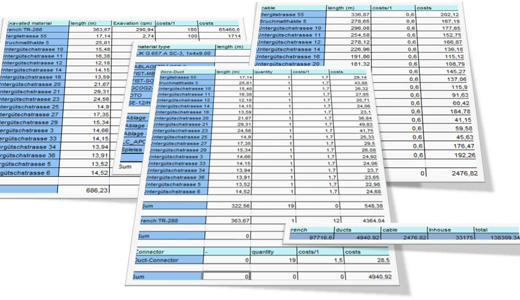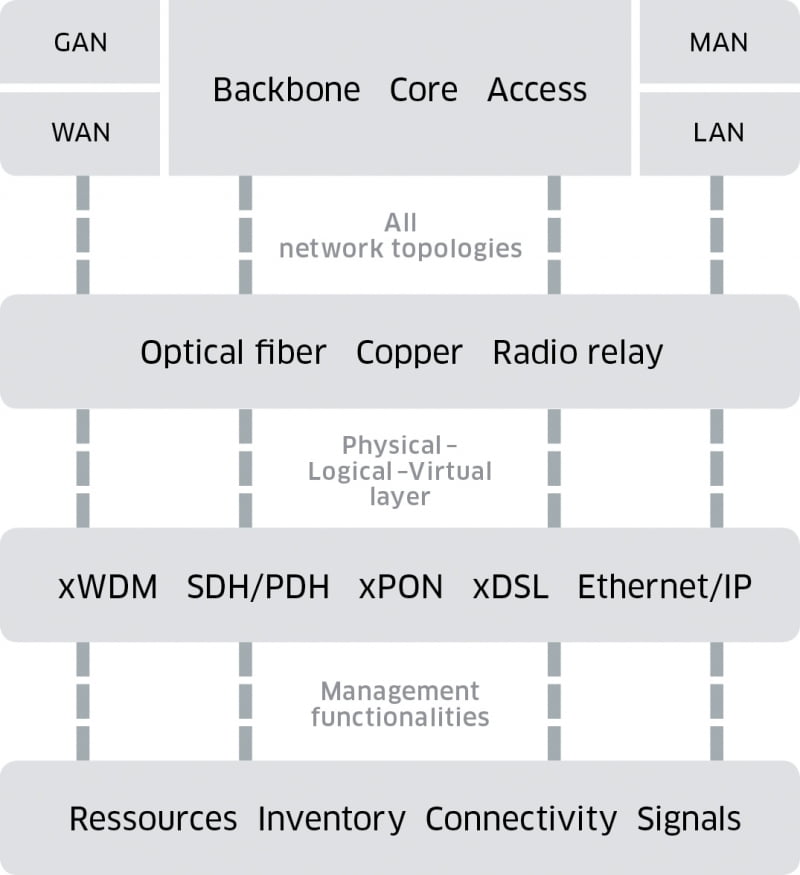Application Areas
cableScout®, the cable management software for all application areas
In recent years, communications and data networks have virtually exploded in terms of size and complexity. This is mainly due to the fact that the network operators must use several transmission and access technologies simultaneously in order to satisfy the constantly growing demand for bandwidth. The administration of these complex mixed networks very much depends on a professional management software like cableScout®.
The universal usability, the wide functional scope and the comprehensive display formats of enable the user to capture, plan and manage the entire depth of a network with all its locations, structures, trenches, manholes, ducts, micro-ducts, distribution cabinets, active and passive components, ports, cables, fibres/wires and signals.
Documentation
cableScout® can continuously capture in detail the physical and the logical resources of a telecommunications network, display them transparently and manage them efficiently.
During data capture great emphasis is placed on the geo-referenced, correct positioning, scale and realistic representation of the objects, which with cableScout® is achieved both by a position-related object list and by mapping object relationships (e.g: cable > duct > trench).
Many attributes, graphics, links and documents can be assigned arbitrarily to each of these network objects. For example, contracts, OTDR-measuring protocols, data sheets, SLAs and invoicing information can be stored for every single fibre and wire in the network.
By using these attributes saved in the database, cableScout® can work proactively and calculate layout length, optical length and individual attenuation values of one installed cable over an entire route. If something were to change on this cable, then all the values affected are automatically adjusted accordingly.
Network documentation compiled using cableScout® is used by the user as a central information basis for those daily recurring tasks and forms the basis for a smooth and cost-optimised network operation.
Planning and design
cableScout® with its wide range of planning functions is key to any future-oriented expansion of telecommunications networks. Every expansion or change considered for the network can be planned fast and efficiently and prepared for implementation.
It is not important for cableScout® whether it is a question of the process for planning smaller measures such as the switch off of a service, the integration of equipment, the laying a cable or whether it is a long-term major action such as to prepare for the construction of a fibre optic ring.
The outcome of the planning process for the user is well-founded information on the costs to be expected, the materials required and the work to be carried out.
Since the planning functions access current inventory documentation, existing physical and logical resources can be utilised to the maximum. This optimised utilisation ensures that unnecessary investments are avoided.
All planning data flows into the special project administration, from where it can be called up again at any time, re-processed or deleted.
The system has the option of breaking down a complex complete project into as many partial activities as needed and assigning these individually to different contractors.
For each of these partial projects the documentation required (work orders, splicing plans, patch and jumpering lists can be output automatically. The person responsible can call up the progress of a project at any time using different status messages directly in the graphics or in the project administration.
If a project has been run properly and accepted accordingly, the feedback to the system and planning data can be transferred seamlessly into the operational documentation.
Administration and operation
In order to the support users in the management of their complex communications networks, cableScout® has a wide range of network-specific and automated functions, graphs, analyses and printouts.
These include signal auto-routing across all media, capacity and load utilisation analyses, automatic length and attenuation calculations, end-to-end reporting of signals and cable routes, feasibility tests and impact analysis for loss of resources.
A particularly popular and frequently used functionality of cableScout® is its powerful route search. Through the use of a high-performance search function the system can search for the routes required within the physical and logical network structure.
The search algorithm goes through the whole network and is then able to incorporate all transmission technologies, active and passive components, cable media, trenches and duct structures. The suggested routes are listed with all the relevant details such as length, number of nodes, capacity utilisation, attenuation, splice/patch points etc. and displayed in the geo-schematic graphic. This ensures that the most appropriate route can always be selected for a specific procedure. For instance it may be a question of an alternative route for a faulty line or a route for switching on new customer signals.
State-of-the-art network management software must also be measured by the information it can output in the form of analyses, printouts and reports. cableScout® also has impressive credentials in this regard due to its specific, detailed and clear printouts and database analyses. In addition to the many standard assessments and reports, the system also has the option of setting up individual database queries and of storing them for permanent usage.
This wide range of management functions enables the user to access all the information required within a very short timeframe. This in turn enables a more professional and more efficient network administration and increases network availability and profitability.







